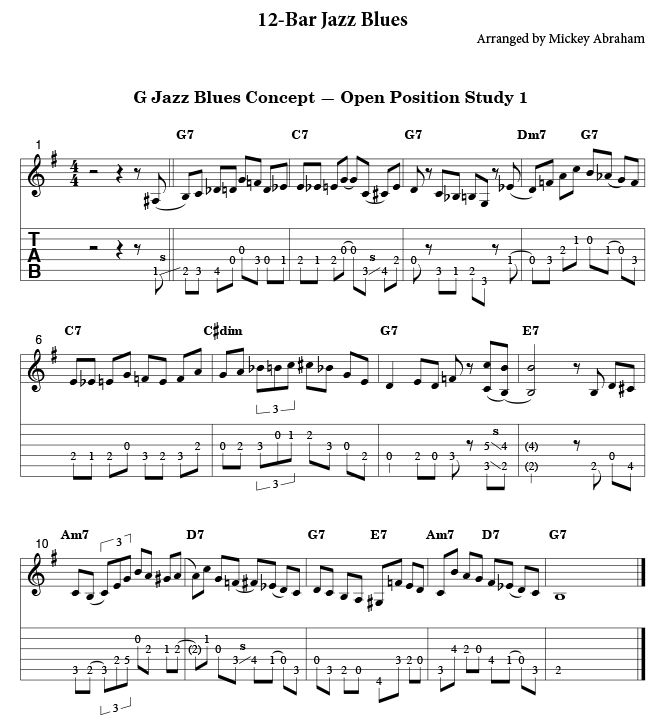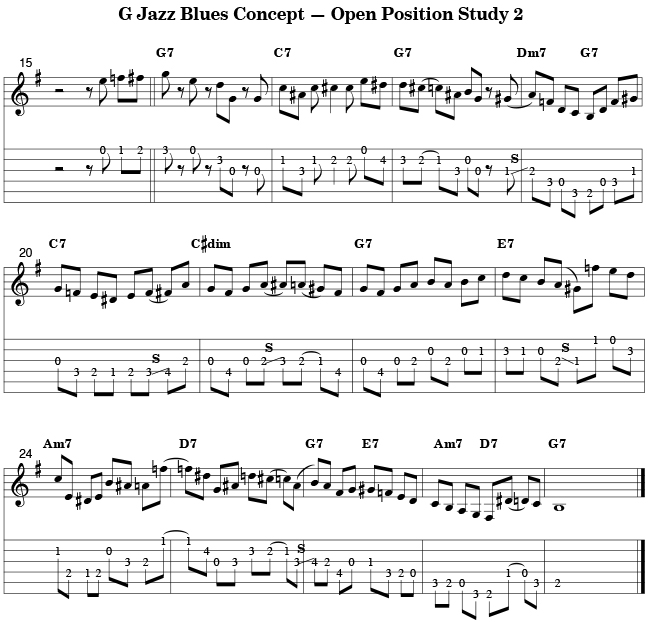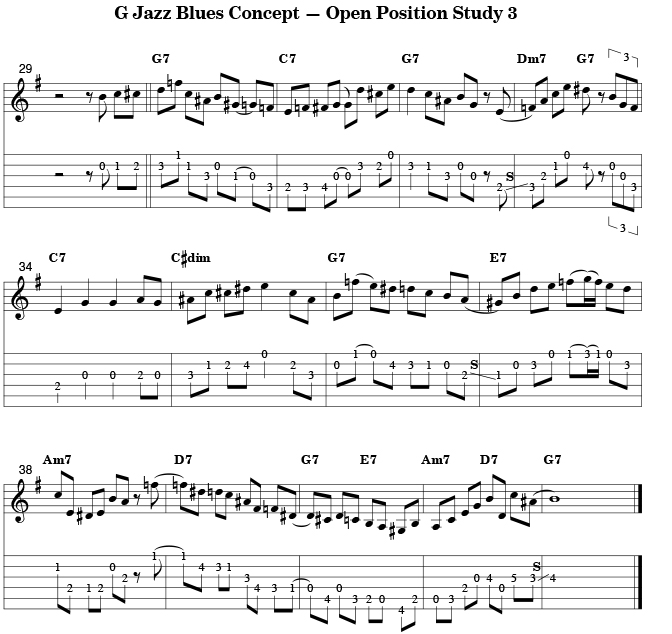|
Flatpicking Guitar Magazine Free Lesson - June 2021 Flatpicking Jazz Blues By Mickey Abraham
Download PDF | Download mp3_1 | Download mp3_2 | Download mp3_3 Hello and welcome once again to Flatpicking Guitar Magazine’s free lesson portion of our monthly newsletter. This month’s lesson deviates from fiddle tunes and ventures into jazz blues. I’ve been attempting to play traditional jazz and bebop ideas in a bluegrass context for a long time and find the styles are very similar. For this lesson I’ve chosen to use the standard 12 bar jazz blues form in the key of G to compose three jazz blues solos for you to learn. What makes these solos unique is the use of the open position on the guitar. Jazz players do not utilize the open position the way bluegrass flatpickers do. There is a lifetime of material to digest when studying jazz blues and I feel these solos will help you on your journey. Each solo is well constructed to outline all of the changes and features traditional bebop language. If you are familiar with a simple 12 bar blues form as well as classic bluegrass G, C, and D phrases you will note that while these licks do look similar to bluegrass and fiddle tune licks they include some interesting note choice and unusual chromatic ideas that are quite different from typical bluegrass runs. If you have never played a jazz blues form it will be important for you to hear how it relates to the traditional blues form. The jazz blues form is very much like a traditional I, IV, V (G, C, D) blues but we add a few additional chord changes. First, we add the quick IV (C7) at measure 2. This addition is common and really gives the blues some motion compared to staying on the I chord for the first four measures. Next, we add a ii-V (Dm7 to G7) progression at measure 4 to approach the IV (C7) chord at measure 5 (note this ii V is in the key of C). The ii V move is very different than what you would expect to hear in a traditional blues and is one of the big reasons why this form sounds jazzy. We also add a passing #IV diminished chord (C#dim) at measure 6. This type of change shows up in many classic swing and blues songs and I’m sure you will recognize the sound and effect the passing #IV diminished chord has on the form. Measure 8 also deviates from the traditional blues form. Here we go form I (G) to VI (E7). For many blues, bluegrass, and rock players this is where the form becomes difficult to solo over and this was definitely the case for me. The E7 chord at measure 8 can sometimes seem to come out of nowhere if you are used to a three chord blues. Even after you know the E7 is coming it can still be tough to get a handle on what to play over it. You will find that your typical E7 bluegrass licks don’t sound exactly right. Once you hear how the E7 is setting up the Am you will get it. Finally we arrive at the turnaround. Here we add a ii, V, I (Am7, D7, G) and a I, VI, ii, V (G, E7, Am7. D7). These chords change so quickly they too can be a source of soloing mystery and frustration. In order to play over a jazz blues turnaround you’ll need to know a few ii V licks and be a master of arpeggios. It’s a fun and worthy challenge to attempt to play lines over jazz blues turnarounds. You can learn these solos note for note without knowing any music theory. Everything you learn in music should help fill in all the holes along the way. Every blues lick, bluegrass run, and jazz idea you learn will enter your playing in some way. These solos employ several jazz concepts that should all be studied in depth like ii V licks, altered dominants, diminished scales, and enclosures. I’m certain you will find these open position jazz blues etudes interesting and inspiring. Many of the lines in these solos are inspired by players such as Joe Pass, Herb Ellis, and Tomo Fujita. If you constantly listen to, learn from, and transcribe your favorite players you will no doubt begin to understand how to construct your own lines with endless variations. As always, should you have any comments or questions just drop me a line at [email protected]



|